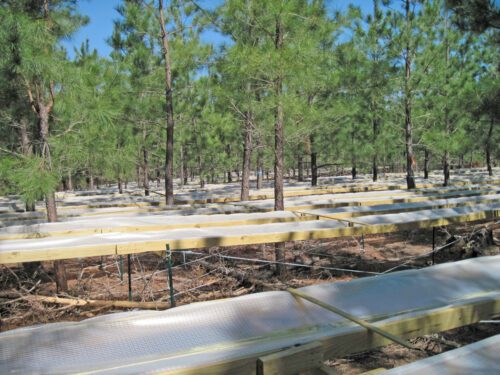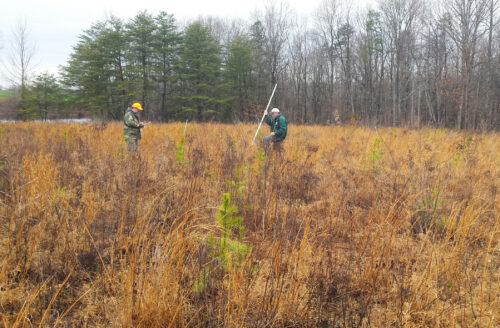 Since 1955, the VDOF has supported a research program to develop answers to forestry questions for Virginia landowners.
Since 1955, the VDOF has supported a research program to develop answers to forestry questions for Virginia landowners.
What Is Forest Research and Why Is It Important?
There is an important distinction between research and casual observation. The studies conducted by our research program follow accepted scientific methods of design and analysis to make sure our results are meaningful and repeatable – not just chance occurrences that could vary from place to place or year to year. Each is planned with a specific question – or hypothesis – in mind.
Field work is the critical component of the process; we carefully map, track, and monitor nearly 55,000 trees in almost 1,000 plots at 100 sites distributed across the forests and regions of the Commonwealth every year. Many are monitored for decades to better track the long-term sustainability and productivity of our forests and how they respond to different treatments or conditions. The results are summarized and delivered in written reports and at workshops and training classes every year.
 Our decades of research have been instrumental in developing the practices currently used in the pine and hardwood forests of Virginia. Thanks to what we’ve learned, the productivity of our pine forests has more than doubled and options for improving the species composition and health of our hardwood forests have been identified and proven.
Our decades of research have been instrumental in developing the practices currently used in the pine and hardwood forests of Virginia. Thanks to what we’ve learned, the productivity of our pine forests has more than doubled and options for improving the species composition and health of our hardwood forests have been identified and proven.
History
Beginning in an age long before modern electronics, our early research subjects involved what today would seem relatively simple and small-scale issues. The first research report issued by the Virginia Department of Forestry – in September 1955 – was a comparison of shortleaf and longleaf pine growth measured on a common central Virginia soil. Working with manual field tools, pencil, and paper, most of the early research consisted of basic counts, measurements, and summaries.
Over the decades, powerful computers, laser range finders, global positioning technology, aerial imagery, and sophisticated laboratory techniques have become widely available. Our recent studies use unmanned aircraft images and DNA mapping, and address subjects such as impacts of climate change and genetics of blight-resistant hybrid American chestnuts. We can complete sophisticated analyses in minutes using computer software that would not have been imagined in the mid-1900s.
Collaboration
Through the years, the VDOF research effort has remained modest in staffing and budget. In recent decades, we have been able to leverage our efforts by collaborating with universities, agencies, and industries with shared interests. The VDOF is a member of the Forest Modeling Research Cooperative based at Virginia Tech, the Forest Productivity Research Cooperative based at North Carolina State University and Virginia Tech, and the Cooperative Tree Improvement Program directed from North Carolina State University. We also work cooperatively with the American Chestnut Foundation, Longleaf Alliance, Shortleaf Initiative, and other groups where we share a common interest. These collaborations give us access to research, analytical resources, and study data many times greater than we could achieve working alone.
Focus Areas
The research program is structured to address five core focus areas:
- Tree improvement and genetics (testing and selecting better growing and healthier families for our nurseries)
- Growth and yield of trees and forests (understanding and predicting long-term forest development)
- Hardwood forest research (primarily naturally-regenerated mixed species stands)
- Pine forest research (primarily loblolly pine plantations)
- Restoring diminished tree species (American chestnut, longleaf pine, and shortleaf pine)
Additional Resources
Learn more about forest inventory at the USDA Forest Service Southern Research Station.
[posts_table columns="image,tax:Audience,title,cf:id_number:ID,content:Description,tax:Media,button" post_type="document-library" rows_per_page="5" exclude_term="Audiences:no, Media:news-releases" term="document-category:research-resource-information" filters="tax:document-category:Select Category,tax:document-tags:Select Tag,tax:Media:Select Content Type"]Contact Us
For more information or questions, e-mail us or use our contact form.
